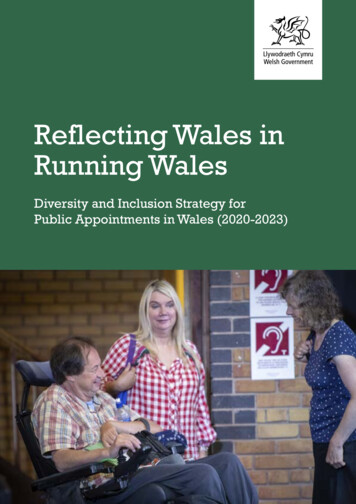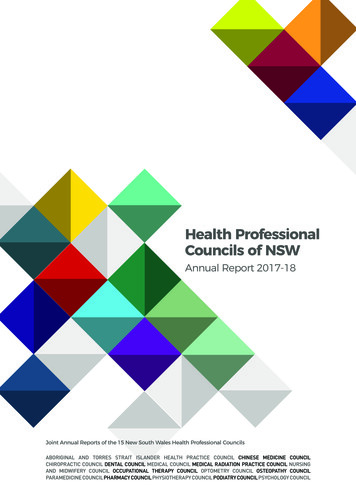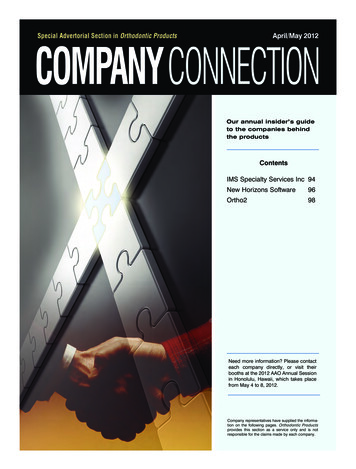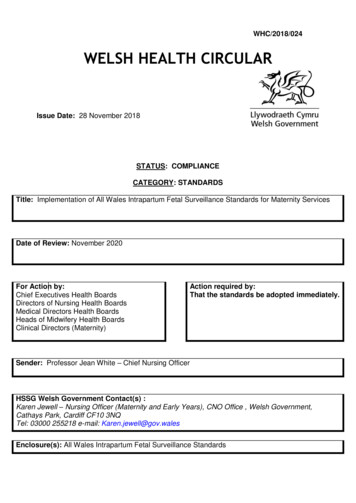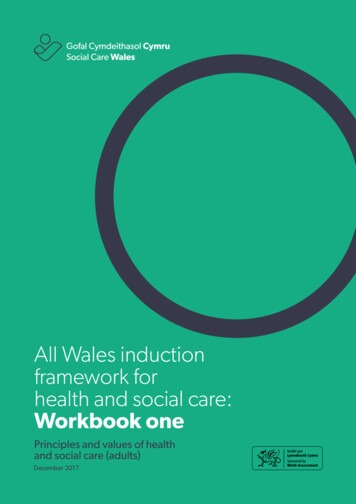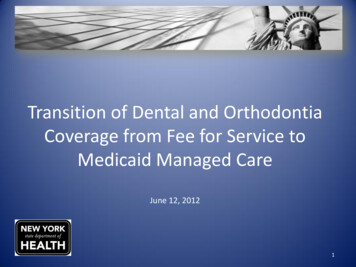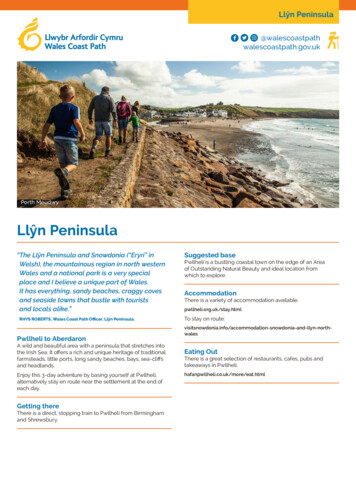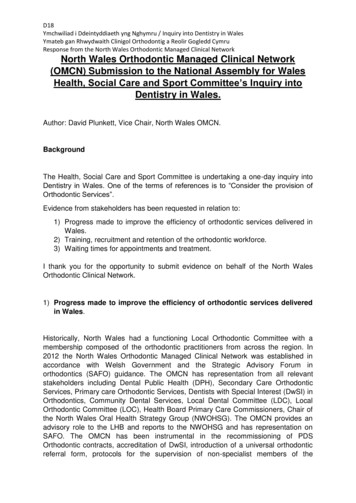
Transcription
D18Ymchwiliad i Ddeintyddiaeth yng Nghymru / Inquiry into Dentistry in WalesYmateb gan Rhwydwaith Clinigol Orthodontig a Reolir Gogledd CymruResponse from the North Wales Orthodontic Managed Clinical NetworkNorth Wales Orthodontic Managed Clinical Network(OMCN) Submission to the National Assembly for WalesHealth, Social Care and Sport Committee’s Inquiry intoDentistry in Wales.Author: David Plunkett, Vice Chair, North Wales OMCN.BackgroundThe Health, Social Care and Sport Committee is undertaking a one-day inquiry intoDentistry in Wales. One of the terms of references is to “Consider the provision ofOrthodontic Services”.Evidence from stakeholders has been requested in relation to:1) Progress made to improve the efficiency of orthodontic services delivered inWales.2) Training, recruitment and retention of the orthodontic workforce.3) Waiting times for appointments and treatment.I thank you for the opportunity to submit evidence on behalf of the North WalesOrthodontic Clinical Network.1) Progress made to improve the efficiency of orthodontic services deliveredin Wales.Historically, North Wales had a functioning Local Orthodontic Committee with amembership composed of the orthodontic practitioners from across the region. In2012 the North Wales Orthodontic Managed Clinical Network was established inaccordance with Welsh Government and the Strategic Advisory Forum inorthodontics (SAFO) guidance. The OMCN has representation from all relevantstakeholders including Dental Public Health (DPH), Secondary Care OrthodonticServices, Primary care Orthodontic Services, Dentists with Special Interest (DwSI) inOrthodontics, Community Dental Services, Local Dental Committee (LDC), LocalOrthodontic Committee (LOC), Health Board Primary Care Commissioners, Chair ofthe North Wales Oral Health Strategy Group (NWOHSG). The OMCN provides anadvisory role to the LHB and reports to the NWOHSG and has representation onSAFO. The OMCN has been instrumental in the recommissioning of PDSOrthodontic contracts, accreditation of DwSI, introduction of a universal orthodonticreferral form, protocols for the supervision of non-specialist members of the
orthodontic team, quality assurance programmes, andestablishing protocols to coversecond opinions and appeal processes, and programmes. Some of these will bediscussed in more detail below.In 2013 the Besti Cadwaladr University Health Board (BCUHB) undertook therecommissioning of primary care Orthodontic PDS Specialist Contracts. This wasundertaken with input from the OMCN to optimise the process. In accordance withbest practice, a Dental Public Health Needs Assessment was undertaken todetermine the required level of activity whilst also taking into consideration crossborder activity, imminent retirements, cessation of assessment only contracts andthe geographic challenges present within North Wales. A Primary Care OrthodonticCommissioning Group was established to undertake the process with representationfrom all the relevant stakeholders including the OMCN, LDC and DPH. Input wasalso obtained from an out of area primary care Orthodontic Specialist to provideadvice on the appropriateness of any planned reduction in UOA rates and thesustainability of business models, as it was recognised that long term financial andclinical viability of the successful bidders was crucial to avoid significant disruption topatient care. In accordance with Welsh Government’s Prudent Health Care agenda,maximisation of orthodontic activity was an important factor during therecommissioning process. It was anticipated that changes in working patterns andthe orthodontic skill mix could offer the opportunity to achieve this aim.After due tendering process, four orthodontic PDS contracts were awarded(geographically based in the 4 main population centres of North Wales). Keycomponents of these new contracts were:1. The overall level of activity (UOA) recurrently contracted by the Health Boardwith specialist orthodontic practices was increased by around 30%, (replacingvarying levels of additional non-recurrent activity previously awarded on anannual basis) with a distribution between practices matching the anticipateddemand set out in the Needs assessment.2. The competitive tender process resulted in a reduction in UOA rate effectivelylimiting the increase in overall contract values to 13%3. Key Performance Indicators (KPI) were introduced into the new contracts toimprove monitoring and maximise the amount of orthodontic activity beingused on treatment starts rather than orthodontic review activity (minimumnumber of treatment starts per year calculated by “contracted UOA 22.5”and only one review per patient in a 24 month period).4. Stipulation was introduced on the appropriate supervision of the non-specialistdental team members (i.e. therapists and GDPs with or without DwSIaccreditation).5. Contract length was increased to 10 years, subject to satisfactoryperformance at review and with an optional break clause after the first 4years. Locally this has resulted in training of orthodontic therapists and
employment of ancillary staff to facilitate this increased activity in the mostefficient manner.A review and extension of Primary Care Specialist Contracts was undertaken inSeptember 2017. At this review, the providers were assessed against the KPIs whichwere included within the contract. The outcome of that assessment determined thedegree of extension which was applied by the HB to the contract.Due to the topography of North Wales and the transport infrastructure associatedwith it, accessing specialist services for those in the most rural communities can bedifficult. It is within this environment that Dentists with a Special Interest (DwSI) inOrthodontics, based with Dental Practice setting, provide such a valuable role.However, it is essential that the patients, Health Boards and Welsh Government canhave confidence in the quality of the service provided. It was on this basis that WelshGovernment stipulated that all orthodontic treatment be undertaken by, or directlysupervised by, an Orthodontic Specialist or accredited DwSI. It was agreed at aNational Wales level that all orthodontic treatment plans should be provided by anorthodontic specialist. So the DwSI Accreditation process, undertaken by BCUHBwith input from the OMCN, examined the ability of the DwSI to both assess the needfor orthodontic intervention and carry out a treatment plan provided by an orthodonticspecialist. This process was competed in 2015.Historically, North Wales consisted of 6 separate Local Health Boards and 3 Trusts.Over time these merged, eventually forming Betsi Cadwaladr UHB in 2009. As suchthere was a legacy of various methods of referral to Specialist Orthodontic Providers(both in Primary and Secondary care) across North Wales. The OMCN wished todevise a regional referral form which would both standardise the informationprovided as well as helping to direct the referral to the most suitable provider. Thereferral form produced was then circulated to the other MCN Chairs to consultationand modification so that an agreed proforma could be produced which would act asa basis for the orthodontic pathway on the forthcoming electronic referralmanagement system. This referral proforma with accompanying guidance documentwas introduced in September 2015 (see Appendix 1 & 2).The electronic Referral Management System (eRMS) for all dental referrals hasbeen commissioned by Welsh Government and is in the process of construction witha planned phased roll out from the end of 2018. It is essential that the local ITinfrastructure is sufficient to support operation of this. The introduction of the eRMSwill allow a streamlining of the referral pathway with better tracking and managementof the referrals received. It should allow improved identification of individuals whorequire priority assessment and treatment as well as utilising internal algorithms tohelp to direct the referral to the most appropriate provider, thus improving theefficiency of the referral pathway and also improving the patient experience.Unfortunately, the introduction of the eRMS itself is not likely to reduce the treatmentneed within the region, so is unlikely to have any long term positive effect on waitingtimes.
North Wales LOC organises an annual Peer Assessment Rating (PAR) scoringaudit. PAR is an internationally recognised method of assessing orthodontictreatment outcomes. It compares the occlusal features of the pre and post treatmentstudy models to produce a PAR reduction score which will give an indication of thequality of the orthodontic treatment. The OMCN and LOC have designed the audit tobe robust (as the cases examined are consecutively completed cases) andinteractive, with each participant scoring other practitioners’ cases randomlyallocated to them. This has the added educational benefit of allowing clinicians tosee the outcomes of treatment that others within the region are achieving andpromotes the raising of standards.2) Training, recruitment and retention of the orthodontic workforce.In North Wales there are five categories of orthodontic clinician:1) Orthodontic Therapist (supervised by an accredited DwSI or OrthodonticSpecialist) – A dental nurse who has undergone a 1 year training period andexamination.2) Non-Accredited DwSI (supervised to the same level as an OrthodonticTherapist) – General Dental Practitioner with orthodontic experience.3) Accredited DwSI (independent orthodontic practitioner working to thetreatment plan of a specialist, treating a more limited case mix, as determinedby their competence, than an orthodontic specialist) - General DentalPractitioner with orthodontic experience who has undertaken and passed theHB’s Accreditation Process.4) Primary care Orthodontic Specialist (on the General Dental Council’sSpecialist List) – Dentally qualified clinician who has undertaken 3 yearsSpecialist Orthodontic training and Royal College examination.5) Consultant Orthodontist (has undertaken additional training and qualificationsbeyond that of a primary care orthodontic specialist) - Dentally qualifiedclinician who has undertaken 3 years Specialist Orthodontic training andRoyal College examination, plus a further 2-2.5 years of advanced trainingand a Royal College Examination.North Wales, in conjunction with the Welsh Deanery and Liverpool Dental Hospital,provides training for a Primary Care Orthodontic Specialist (StR 1-3) and aConsultant Orthodontist (StR 4-5). There is evidence that clinicians are more likelytake up a permanent post either around where they trained or where they havepersonal connections, it is therefore essential that North Wales continues to providetraining opportunities to maximise the potential for future specialists to take uppermanent posts within the region.
North Wales, like many rural areas, finds it challenging to attract and retain medicaland dental professionals. This applies to the Specialty of Orthodontics especiallywithin the secondary care sector as there are fewer appropriately trained cliniciansand there is a discrepancy between supply and demand with currently at least 48unfilled consultant positions within the UK. It is therefore essential that successionplanning for anticipated retirements is planned well in advance. In addition, the poststhemselves need to be attractive and enable the prospective candidates to enjoy thefull remit of the orthodontic consultant. This will include educational opportunities,extended management roles and being able to foster good clinical relationships withthe other specialties within the Multidisciplinary team. The HB needs to be proactiveand adaptive in the recruitment process to ensure that suitable candidates are lost toother areas.3) Waiting times for appointments and treatment.NHS Orthodontic treatment is undertaken according to clinical need. This need isdetermined by the Index of Orthodontic Treatment Need [IOTN], which assessesfeatures of the presenting malocclusion and allows its categorisation. The level of theIOTN above which treatment on the NHS is available is currently 4 & 5 or 3 with anaesthetic component of 6 (the aesthetic component is scored from 1-10, with 10being the most severe). This threshold could be raised to only include categories 4 &5 (great treatment need).The introduction of the Regional referral form has helped guide the patient to themost appropriate provider in the first instance. However, to ensure that the service isequitable, it a patient is seen in one sector, but upon assessment it is felt to be moreappropriately managed in another sector, then the time spent waiting for the initialassessment is taken into consideration by the subsequent provider.The current waiting times within North Wales are:Primary Care:- Tameside: 18-20 months for initial assessment, then 1 month wait tocommence treatment.- Greenacres: 16 months for initial assessment, then 2-3 months wait tocommence treatment.- Total Orthodontics (Colwyn Bay): 18 months for initial assessment, then 1month wait to commence treatment.- Total Orthodontics (Wrexham): 18 months for initial assessment, then 1month wait to commence treatment.- CDS: Initial assessment dependant on waiting times to seek treatment planfrom a Specialist (as per DwSI stipulation), with a 12 month wait to commencetreatmentSecondary Care:- Wrexham: Initial assessment within 26 weeks, then a 24 month wait tocommence treatment.
-Glan Clwyd: Initial assessment within 26 weeks, then a 37 month wait tocommence treatment.Bangor: Initial assessment within 26 weeks, then an 18 month wait tocommence treatment.The current waiting times within Powys are:Primary Care – 4-12 weeks for an initial assessment, and then 2 months wait tocommence treatmentSecondary Care (Brecon) – Initial assessment in 18-20 weeks, then a 30 month waitto commence treatment.Following the retendering of primary care Specialist Practice PDS Contracts inBCUHB in 2014, the waiting times in Primary Care appear to have stabilised around18 months. However, this regional “backlog” of 18 months is unlikely to reducesignificantly within the current funding arrangements. In addition, the NeedsAssessment took into consideration the historic cross border activity into England(this was present on the introduction of the 2006 Dental Contract) which equates to400 cases per annum and is still utilised by referring GDPs in North East Wales.There is concern that the proposed recommissioning of primary care OrthodonticContracts in Cheshire will prevent this ongoing cross border activity which will have anegative effect on the current waiting times within North Wales.Waiting times in the secondary care sector have increased dramatically over the last5 years. In line with Wales’ Prudent Health Care agenda, only the cases that havethe required complexity are treated in a secondary care setting. Unfortunately,departing colleagues, difficulties in attracting suitably qualified staff and significantdelays in the recruiting process has resulted in missed opportunities to appointsuitable candidates both in the orthodontic and restorative specialties and this hasled to increasing waiting time from assessment to commencement of treatment. Inaddition, prioritisation of achieving the Referral To Treatment target for new patientassessments of 26 weeks has meant additional patients being added to the validatedtreatment waiting list with the same or reduced treatment capacity. Vacancies andother clinical pressures in the related Multi-Disciplinary Team Specialties means thatcertain cohorts of orthodontic patients are not progressing with their treatment asefficiently as would be desirable.
4. Summary and RecommendationsThe OMCN, with good support from BCUHB Commissioners and all local orthodonticproviders have dramatically improved the provision of orthodontic treatment acrossthe North Wales region. Our model has ensured 30% more treatment activity withinthe primary care setting, with activity directed to treatments rather than assessments.The primary care waiting lists remain stable; whereas, anecdotally, they continue torise in other parts of the U.K. The existing waiting lists reflect the historic situationand, although not ideal, reflect an accurate needs assessment and targetedcommissioning to ensure activity has increased to met the demand.In secondary care, waiting lists have risen. This is due to difficulties in attractingsuitable staff members to the area, and efforts should be encouraged to improve therecruitment process and develop the job opportunities to attract new consultants intothe region.The core structure of these strategic changes has been the development of aneffective Orthodontic Managed Clinical Network, and BCUHB commissionerspositively engaged with this group to ensure the success of these large and positivechanges.As a result of the above measures, the BCUHB have been able to develop a uniquemodel for providing Primary Care NHS Orthodontic Treatment. It has increasedservice capacity and improved access issues previously experienced by patients ingeographically remote areas. At the same time, it has developed robust monitoringprocesses to ensure that these treatments are performed to the highest clinicalstandards. Importantly, this model has taken a long term view and has providedstability to the provision of care.RecommendationsA) Great efforts have been undertaken locally to increase the standard andefficiency of orthodontic provision within the Region. Time now needs to begiven to consolidate these improvements as well as allowing the otherplanned initiatives to be implemented and their effect assessed.B) To continue to ensure that the OMCNs are fully functioning with theengagement of all stakeholders and that the OMCN are adequately supportedby the HBs.C) To continue to monitor the quality of outcomes for all orthodontic clinicianswith responsibility for the outcome of treatment within the Region.D) To ensure the continuity of the training posts within North Wales and toestablish a pathway for DwSI training for future succession planning.
E) To establish the eRMS, ensuring local IT infrastructure is capable ofsupporting its use. Use the eRMS to monitor the quality and appropriatenessof referrals.F) To agree what would be an appropriate and acceptable time from routinereferral to the commencement of treatment and to fund additional time limitedactivity to achieve this aim, and the additional ongoing resources to maintainit.G) To ensure that, with Welsh Government support, the historic cross borderactivity into Cheshire remains following any recommissioning exercise toPrimary Care Orthodontic Contract.H) For Welsh Government and LHBs to recognise the importance of coordinatedand timely management of retirements and other clinical vacancies to ensureminimal disruption to clinical services and patient care.
Appendix 1 - Referral GuidanceREGIONAL UNIVERSAL NHS ORTHODONTIC REFERRAL PROFORMADear Colleague,The Local Health Board in partnership with the North Wales Orthodontic Managed Clinical Network(MCN) have produced a regional universal NHS orthodontic referral proforma which is to be used byall practitioners when referring patients to access NHS Orthodontic services, whether this be inPrimary or Secondary care. This referral form will cover North Wales & Powys (all areas whereorthodontic treatment is funded by Betsi Cadwaladr University Health Board & Powys TeachingHealth Board). It aims to provide a transitional step before the introduction of electronic referralsbecome mainstream (timeframe for electronic referrals introduction will be dependent on WelshAssembly Government funding).The referral form itself has been designed to help guide practitioners to the most appropriateservice provider to whom to refer their patients on for an assessment. A simple “tick box”arrangement has been utilised with an additional free text space for any extra information thereferring practitioner feels would be advantageous to be included.Access to NHS Orthodontic treatment is via the application of the Index of Orthodontic TreatmentNeed (IOTN), with only categories 4 & 5 and some category 3 being eligible to receive treatmentfunded by the NHS. An explanation of the IOTN is provided below along with an overview of possibleoutcomes following a patient assessment by an orthodontic specialist.Only patients who meet the IOTN threshold criteria and who are aged under 18 years old when theycommence orthodontic treatment will usually be eligible for NHS funded treatment in SpecialistPractice. In view of the current regional waiting times, patients should be referred for a Specialistassessment prior to their 17th birthday. If done so, the LHB will honour the commitment for fundingorthodontic treatment for these patients (if they reach the threshold for treatment need) even ifthey turn 18 whilst waiting for an orthodontic assessment and commencement of treatment. Noguarantee of orthodontic funding will be made by the LHB for patients who turn 18 whilst waiting foran assessment if they have been referred after they turn 17 years old. Patients over the age of 18years old may be eligible for treatment in Hospital Orthodontic Departments if they are of a morecomplex nature often requiring multidisciplinary care.This Universal Referral Form immediately replaces all other referral forms currently in circulationand as of the 1st September 2015. Only referrals using this Universal Orthodontic NHS ReferralProforma will be accepted by any orthodontic provider. Any referrals not received on this form afterthis date will be returned to the referring practitioner.Yours sincerely,Lynne JoannouAssistant Director ofPrimary Care SupportBCUHBWarren TolleyClinic Dental DirectorPowys Teaching LBBenjamin LewisChair of the North WalesOrthodontic MCN
Dental Health Component of IOTNTreatment Need From A Dental Health Perspective (5 Grades)Dental Health Component of IOTNGrade 5 (GreatNeed ForTreatment)5i5h5a5mGrade 4 (Need ForTreatment)5p5s4h4a4b4m4c4l4d4e4f4tGrade 3(Borderline NeedFor Treatment)4x3a3b3c3d3e3fImpeded eruption of teeth (except third molars) due tocrowding, displacement, the presence of supernumeraryteeth, retained deciduous teeth and any pathological causeExtensive hypodontia (more than 1 tooth missing in anyquadrant) requiring pre-restorative orthodonticsIncreased overjet greater than 9mmReverse overjet greater than 3.5mm with reported masticatory& speech difficultiesDefects of cleft lip and palate and other craniofacial anomaliesSubmerged deciduous teethLess extensive hypodontia requiring prerestorativeorthodontics or orthodontic space closure to obviate the needfor a prosthesisIncreased overjet greater than 6mm but less than or equal to9mmReverse overjet greater than 3.5mm with no masticatory orspeech difficultiesReverse overjet greater than 1mm but less than 3.5mm withrecorded masticatory and speech difficultiesAnterior or posterior crossbites with greater than 2mmdiscrepancy between retruded contact position andintercuspal positionPosterior lingual crossbite with no functional occlusal contactin one or both buccal segmentsSevere contact point displacements greater than 4mmExtreme lateral or anterior open bites greater than 4mmIncreased and complete overbite with gingival or palataltraumaPartially erupted teeth, tipped and impacted against adjacentteethPresence of supernumerary teethIncreased overjet greater than 3.5mm but less than or equal to6mm with incompetent lipsReverse overjet greater than 1mm but less than or equal to3.5mmAnterior or posterior crossbites with greater than 1mm butless than or equal to 2mm discrepancy between retrudedcontact position and intercuspal positionContact point displacement greater than 2mm but less than orequal to 4mmLateral or anterior open bite greater than 2mm but less thanor equal to 4mmDeep overbite complete on gingival or palatal tissues, but notrauma
Grade 2 (LittleNeed ForTreatment)2a3b2c2d2e2f2gGrade 1 (No NeedFor Treatment)1Increased overjet greater than 3.5mm but less than or equal to6mm with competent lipsReverse overjet greater than 0mm but less than or equal to1mmAnterior or posterior crossbite with less than or equal to 1mmdiscrepancy between retruded contact position andintercuspal positionContact point displacements greater than 1mm but less thanor equal to 2mmAnterior or posterior openbite greater than 1mm but less thanor equal to 2mmIncreased overbite greater than or equal to 3.5mm withoutgingival contactPre-normal or post-normal occlusions with no other anomalies(includes up to half a unit discrepancy)Extremely minor malocclusions including contact pointdisplacement less than 1mmScores in green are automatically eligible for NHS fundingScore in yellow may be eligible for NHS funding but requires an aesthetic score of 6 oraboveScores in red are not eligible for NHS fundingThe second part of the IOTN is the Aesthetic Component (AC)The NHS does recognise that some children need and benefit from orthodontic treatmenton the basis of poor aesthetics. The Aesthetic Component of the IOTN is a scale of 10 colourphotographs showing different levels of dental attractiveness. The grading is made by theorthodontist matching the patient to these photographs. The photographs were arranged inorder by a panel of lay persons.Within the NHS if a patient in Dental Health category 3 has an Aesthetic Component ratingof 6 or more NHS treatment is permissible
Aesthetic Component of IOTN (AC) 10 Point ScaleNo TreatmentTreatment
Steps orthodontic providers are likely to consider when reviewing a referraland possible outcomes following an orthodontic assessment1. Consultant OrthodontistDoes referral appear to meet criteria for hospital service?- No.Refer back to GDP to refer on to specialist practice as appropriate- Yes.Is the referral higher priority? Yes – Arrange appropriate priority appointment No – Place on list for routine consultationAfter consultation required action is:- treatment suitable for Dentist with Special Interest – refer to DwSI withtreatment plan- treatment suitable for specialist practice – refer tospecialist practice- complex treatment needing hospital care: Higher priority – list with appropriate priority for treatment oronward referral Routine – place on treatment waiting list- orthognathic treatment – arrange joint clinic appointment- restorative treatment – arrange joint clinic consultation- not ready for treatment but needs to be kept under review – arrangereview- unlikely to be ready for treatment within 12 months and review not needed– refer back to GDP- no treatment indicated – refer back to GDP
Specialist PracticeDoes referral appear to meet criteria for specialist practice service?- No.Refer back to GDP or refer on to consultant as appropriate- Yes.Is the referral higher priority? Yes – Arrange appropriatepriority appointment No – Arrange routine appointment or place on waiting list.After consultation action required is:- treatment is within scope of specialist practice – book to treatment clinic orplace on waiting list- advice or treatment more suitable for hospital service – refer to consultant- patient not ready for treatment: likely to be ready within 12 months – review unlikely to be ready within 12 months – refer back to GDP- treatment not indicated – refer back to GDP
Appendix 2 –North Wales & Powys Orthodontic Referral proforma
orthodontic team, quality assurance programmes, andestablishing protocols to cover second opinions and appeal processes, and programmes. Some of these will be discussed in more detail below. In 2013 the Besti Cadwaladr University Health Board (BCUHB) undertook the recommissioning of primary care Orthodontic PDS Specialist Contracts.

